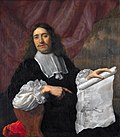English: Beach and Van Ghent destroy six Barbary ships near Cape Spartel, Morocco, 17 August 1670
Cruising off the Straits of Gibraltar, a squadron of seven Algerine corsair, or Barbary, ships were causing considerable damage to both the English and Dutch Mediterranean trade from Algiers. By August 1670 the English commander Sir Thomas Allin and the Dutch admiral Willem Joseph, Baron van Ghent collaborated to prevent the corsairs reaching Algiers. The English despatched Commodore Richard Beach with a small squadron to join the Dutch. Between 14 and 24 August, Dutch ships pursued six of the corsair ships for several days until land was reached near Cape Spartel, where they were engaged in action. The corsair ships attempted to escape along the coast. On the 17 August Beach arrived with his five ships and cut off their escape to the north. During the night the corsair ships ran themselves ashore at high water and most of the crew left the ships. The following morning boats from the Dutch and English ships took possession of the three Algerine flagships. However, they remained aground and couldn’t be shifted. As all six boats began to break up in the surf, the English boats freed as many Christian slaves as they could and then set fire to the ships. A number of contemporary accounts of this event still exist. Sir Thomas Allin wrote an account of his operations in the Mediterranean against the Algerines and corsairs and described the destruction of six Algerine men-of-war off Cape Spartel when 250 Christian captives were released. A letter from Samuel Daukes contains a description of the sufferings of the captives.
In this continuous narrative painting made from the English perspective, five English ships in the foreground fly the red ensign. Van Ghent’s flagship and two other Dutch ships are in the right background. The six Barbary ships are shown spread along the shore in the distance and on fire, although this did not take place until the following day. Cape Spartel is in the left distance. The sun is shown from the left with a shadow falling across the sea in the foreground. In the centre foreground the ‘Portsmouth’ is shown at anchor, and ahead of her is Commodore Beach’s flagship the ‘Hampshire’ firing her port guns. She is the only English ship shown with a pendant the leading ship to the right having a Commodore’s red pennant with the Cross of St George at the main. On ‘Portsmouth’s’ port beam starboard quarter view the ‘Jersey’ fires her port guns. Astern of the ‘Jersey’ is the ‘Foresight’ view under way. In the background beyond the ‘Foresight’ is the ‘Centurion’ coming to the wind under fore and main sails topmast and mizzen.
In the right background Van Ghent’s ship is at anchor with his flag in the ‘Spiegel’; there are two other ships near the ‘Spiegel’ one of them with only the after part showing. On the extreme right are three Dutch men-of-war the one nearest to the English squadron wearing the Dutch flag at the main and all three ships are flying the orange white and blue Dutch ensign. In the bottom right hand corner is a painted scroll superimposed on the sea which reproduces the painting in miniature and in grisaille. The English ships are identifiable by six associated van de Velde drawings in the NMM Collection.









